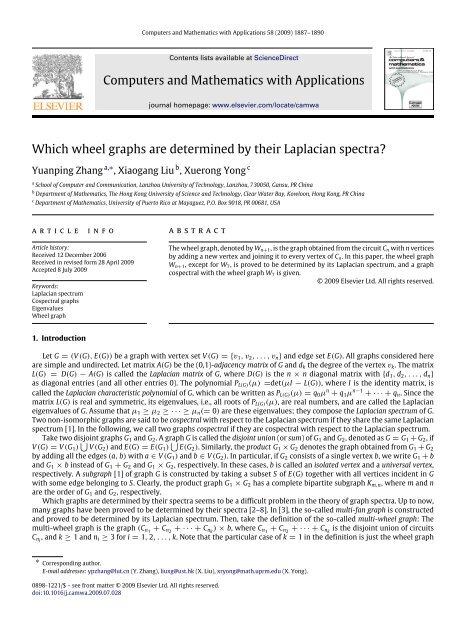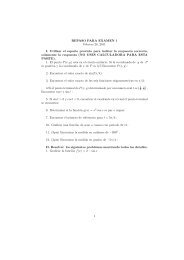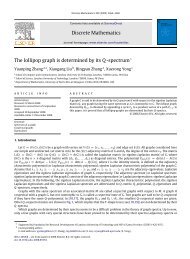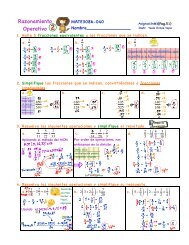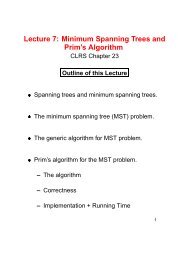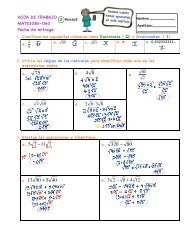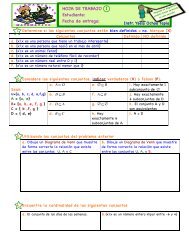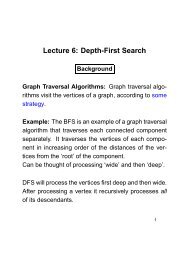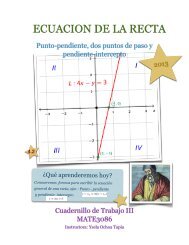Which wheel graphs are determined by their Laplacian ... - UPRM
Which wheel graphs are determined by their Laplacian ... - UPRM
Which wheel graphs are determined by their Laplacian ... - UPRM
Create successful ePaper yourself
Turn your PDF publications into a flip-book with our unique Google optimized e-Paper software.
Computers and Mathematics with Applications 58 (2009) 1887–1890<br />
Contents lists available at ScienceDirect<br />
Computers and Mathematics with Applications<br />
journal homepage: www.elsevier.com/locate/camwa<br />
<strong>Which</strong> <strong>wheel</strong> <strong>graphs</strong> <strong>are</strong> <strong>determined</strong> <strong>by</strong> <strong>their</strong> <strong>Laplacian</strong> spectra?<br />
Yuanping Zhang a,∗ , Xiaogang Liu b , Xuerong Yong c<br />
a School of Computer and Communication, Lanzhou University of Technology, Lanzhou, 730050, Gansu, PR China<br />
b Department of Mathematics, The Hong Kong University of Science and Technology, Clear Water Bay, Kowloon, Hong Kong, PR China<br />
c Department of Mathematics, University of Puerto Rico at Mayaguez, P.O. Box 9018, PR 00681, USA<br />
a r t i c l e<br />
i n f o<br />
a b s t r a c t<br />
Article history:<br />
Received 12 December 2006<br />
Received in revised form 28 April 2009<br />
Accepted 8 July 2009<br />
Keywords:<br />
<strong>Laplacian</strong> spectrum<br />
Cospectral <strong>graphs</strong><br />
Eigenvalues<br />
Wheel graph<br />
The <strong>wheel</strong> graph, denoted <strong>by</strong> W n+1 , is the graph obtained from the circuit C n with n vertices<br />
<strong>by</strong> adding a new vertex and joining it to every vertex of C n . In this paper, the <strong>wheel</strong> graph<br />
W n+1 , except for W 7 , is proved to be <strong>determined</strong> <strong>by</strong> its <strong>Laplacian</strong> spectrum, and a graph<br />
cospectral with the <strong>wheel</strong> graph W 7 is given.<br />
© 2009 Elsevier Ltd. All rights reserved.<br />
1. Introduction<br />
Let G = (V(G), E(G)) be a graph with vertex set V(G) = {v 1 , v 2 , . . . , v n } and edge set E(G). All <strong>graphs</strong> considered here<br />
<strong>are</strong> simple and undirected. Let matrix A(G) be the (0,1)-adjacency matrix of G and d k the degree of the vertex v k . The matrix<br />
L(G) = D(G) − A(G) is called the <strong>Laplacian</strong> matrix of G, where D(G) is the n × n diagonal matrix with {d 1 , d 2 , . . . , d n }<br />
as diagonal entries (and all other entries 0). The polynomial P L(G) (µ) =det(µI − L(G)), where I is the identity matrix, is<br />
called the <strong>Laplacian</strong> characteristic polynomial of G, which can be written as P L(G) (µ) = q 0 µ n + q 1 µ n−1 + · · · + q n . Since the<br />
matrix L(G) is real and symmetric, its eigenvalues, i.e., all roots of P L(G) (µ), <strong>are</strong> real numbers, and <strong>are</strong> called the <strong>Laplacian</strong><br />
eigenvalues of G. Assume that µ 1 ≥ µ 2 ≥ · · · ≥ µ n (= 0) <strong>are</strong> these eigenvalues; they compose the <strong>Laplacian</strong> spectrum of G.<br />
Two non-isomorphic <strong>graphs</strong> <strong>are</strong> said to be cospectral with respect to the <strong>Laplacian</strong> spectrum if they sh<strong>are</strong> the same <strong>Laplacian</strong><br />
spectrum [1]. In the following, we call two <strong>graphs</strong> cospectral if they <strong>are</strong> cospectral with respect to the <strong>Laplacian</strong> spectrum.<br />
Take two disjoint <strong>graphs</strong> G 1 and G 2 . A graph G is called the disjoint union (or sum) of G 1 and G 2 , denoted as G = G 1 + G 2 , if<br />
V(G) = V(G 1 ) ⋃ V(G 2 ) and E(G) = E(G 1 ) ⋃ E(G 2 ). Similarly, the product G 1 × G 2 denotes the graph obtained from G 1 + G 2<br />
<strong>by</strong> adding all the edges (a, b) with a ∈ V(G 1 ) and b ∈ V(G 2 ). In particular, if G 2 consists of a single vertex b, we write G 1 + b<br />
and G 1 × b instead of G 1 + G 2 and G 1 × G 2 , respectively. In these cases, b is called an isolated vertex and a universal vertex,<br />
respectively. A subgraph [1] of graph G is constructed <strong>by</strong> taking a subset S of E(G) together with all vertices incident in G<br />
with some edge belonging to S. Clearly, the product graph G 1 × G 2 has a complete bipartite subgraph K m,n , where m and n<br />
<strong>are</strong> the order of G 1 and G 2 , respectively.<br />
<strong>Which</strong> <strong>graphs</strong> <strong>are</strong> <strong>determined</strong> <strong>by</strong> <strong>their</strong> spectra seems to be a difficult problem in the theory of graph spectra. Up to now,<br />
many <strong>graphs</strong> have been proved to be <strong>determined</strong> <strong>by</strong> <strong>their</strong> spectra [2–8]. In [3], the so-called multi-fan graph is constructed<br />
and proved to be <strong>determined</strong> <strong>by</strong> its <strong>Laplacian</strong> spectrum. Then, take the definition of the so-called multi-<strong>wheel</strong> graph: The<br />
multi-<strong>wheel</strong> graph is the graph (C n1 + C n2 + · · · + C nk ) × b, where C n1 + C n2 + · · · + C nk is the disjoint union of circuits<br />
C ni , and k ≥ 1 and n i ≥ 3 for i = 1, 2, . . . , k. Note that the particular case of k = 1 in the definition is just the <strong>wheel</strong> graph<br />
∗ Corresponding author.<br />
E-mail addresses: ypzhang@lut.cn (Y. Zhang), liuxg@ust.hk (X. Liu), xryong@math.uprm.edu (X. Yong).<br />
0898-1221/$ – see front matter © 2009 Elsevier Ltd. All rights reserved.<br />
doi:10.1016/j.camwa.2009.07.028
1888 Y. Zhang et al. / Computers and Mathematics with Applications 58 (2009) 1887–1890<br />
Fig. 1. The cospectral <strong>graphs</strong> W 7 and G.<br />
W n1 +1 = C n1 × b with n 1 + 1 vertices. In this paper, the <strong>wheel</strong> graph W n+1 , except for W 7 , will be proved to be <strong>determined</strong><br />
<strong>by</strong> its <strong>Laplacian</strong> spectrum. This method is also useful in proving that the multi-<strong>wheel</strong> graph (C n1 + C n2 + · · · + C nk ) × b<br />
is <strong>determined</strong> <strong>by</strong> its <strong>Laplacian</strong> spectrum, where k ≥ 2. Here, we will skip the details of the proof for multi-<strong>wheel</strong> <strong>graphs</strong>.<br />
In [9], a new method (see Proposition 4 in [9]) is pointed out, which can be used to prove that every multi-<strong>wheel</strong> graph<br />
(C n1 + C n2 + · · · + C nk ) × b is <strong>determined</strong> <strong>by</strong> its <strong>Laplacian</strong> spectrum, where k ≥ 2. But, for the <strong>wheel</strong> graph W n+1 , the new<br />
method in [9] is useless.<br />
2. Preliminaries<br />
Some previously established results about the spectrum <strong>are</strong> summarized in this section. They will play an important role<br />
throughout the paper.<br />
Lemma 2.1 ([10]). Let G 1 and G 2 be <strong>graphs</strong> on disjoint sets of r and s vertices, respectively. If µ 1 ≥ µ 2 ≥ · · · ≥ µ r (= 0) and<br />
η 1 ≥ η 2 ≥ · · · ≥ η s (= 0) <strong>are</strong> the <strong>Laplacian</strong> spectra of <strong>graphs</strong> G 1 and G 2 , respectively, then r + s; µ 1 + s, µ 2 + s, . . . , µ r−1 +<br />
s; η 1 + r, η 2 + r, . . . , η s−1 + r; and 0 <strong>are</strong> the <strong>Laplacian</strong> spectra of graph G 1 × G 2 .<br />
Lemma 2.2 ([11]).<br />
(1) Let G be a graph with n vertices and m edges and d 1 ≥ d 2 ≥ · · · ≥ d n its non-increasing degree sequence. Then some of the<br />
coefficients in P L(G) (µ) <strong>are</strong><br />
q 0 = 1; q 1 = −2m; q 2 = 2m 2 − m − 1 n∑<br />
d 2 i<br />
2<br />
;<br />
q n−1 = (−1) n−1 nS(G); q n = 0<br />
where S(G) is the number of spanning trees in G.<br />
(2) For the <strong>Laplacian</strong> matrix of a graph, the number of components is <strong>determined</strong> from its spectrum.<br />
Lemma 2.3 ([12]). Let graph G be a connected graph with n ≥ 3 vertices. Then d 2 ≤ µ 2 .<br />
Lemma 2.4 ([13,11]). Let G be a graph with n ≥ 2 vertices. Then d 1 + 1 ≤ µ 1 ≤ d 1 + d 2 .<br />
i=1<br />
Lemma 2.5 ([14]). If G is a simple graph with n vertices, then m G (n) ≤ ⌊ d n<br />
n−d 1<br />
⌋, where m G (n) is the multiplicity of the eigenvalue<br />
n of L(G) and ⌊x⌋ the greatest integer less than or equal to x.<br />
Lemma 2.6 ([15]). Let G be the complement of a graph G. Let µ 1 ≥ µ 2 ≥ · · · ≥ µ n = 0 and µ 1 ≥ µ 2 ≥ · · · ≥ µ n = 0 be the<br />
<strong>Laplacian</strong> spectra of <strong>graphs</strong> G and G, respectively. Then µ i + µ n−i = n for any i ∈ {1, 2, . . . , n − 1}.<br />
Lemma 2.7 ([16]). Let G be a connected graph on n vertices. Then n is an eigenvalue of <strong>Laplacian</strong> matrix L(G) if and only if G is<br />
the product of two <strong>graphs</strong>.<br />
3. Main results<br />
First, let us check that the <strong>graphs</strong> G and W 7 in Fig. 1 <strong>are</strong> cospectral. By using Maple, the <strong>Laplacian</strong> characteristic<br />
polynomials of the <strong>graphs</strong> G and W 7 <strong>are</strong> both<br />
µ 7 − 24µ 6 + 231µ 5 − 1140µ 4 + 3036µ 3 − 4128µ 2 + 2240µ.<br />
That is, G and W 7 <strong>are</strong> cospectral. Then, we will have the following proposition.<br />
Proposition 3.1. The <strong>wheel</strong> graph W 7 is not <strong>determined</strong> <strong>by</strong> its <strong>Laplacian</strong> spectrum.<br />
Theorem 3.2. The <strong>wheel</strong> graph W n+1 , except for W 7 , is <strong>determined</strong> <strong>by</strong> its <strong>Laplacian</strong> spectrum.
Y. Zhang et al. / Computers and Mathematics with Applications 58 (2009) 1887–1890 1889<br />
Fig. 2. Graph with the degree sequence 4, 4, 4, 3, 3, 2.<br />
Proof. Since the <strong>Laplacian</strong> spectrum of the circuit C n is 2−2 cos 2πi<br />
n<br />
(i = 1, 2, . . . , n), <strong>by</strong> Lemma 2.1, the <strong>Laplacian</strong> spectrum<br />
of W n+1 is 3 − 2 cos 2πi (i = 1, 2, . . . , n − 1), and also 0 and n + 1. Suppose a graph G is cospectral with W n n+1. Lemma 2.2<br />
implies that graph G has n + 1 vertices, 2n edges and one component. Then, <strong>by</strong> Lemma 2.7, G is a product of two <strong>graphs</strong>.<br />
Let d 1 ≥ d 2 ≥ · · · ≥ d n+1 be the non-increasing degree sequence of <strong>graphs</strong> G. By Lemma 2.3, d 2 ≤ µ 2 ≤ 5, i.e., d 2 ≤ 5.<br />
Lemma 2.4 implies that d 1 + 1 ≤ n + 1 ≤ d 1 + d 2 ≤ d 1 + 5, i.e., n − 4 ≤ d 1 ≤ n. Consider the following cases for d 1 .<br />
Case 1. d 1 = n − 4. Since the multiplicity of the µ 1 = n + 1 is 1, <strong>by</strong> Lemma 2.5, 1 ≤ ⌊<br />
n+1−(n−4) ⌋, i.e., d n+1 ≥ 5. Then,<br />
d 2 = d 3 = · · · = ∑ d n = d n+1 = 5, i.e., there exist at least n vertices of degree five in graph G. But, 5n + (n − 4) ≠ 2(2n), a<br />
n+1<br />
contradiction to<br />
i=1 d i = 2m, where m is the number of edges in G.<br />
d<br />
Case 2. d 1 = n − 3. Since the multiplicity of the µ 1 = n + 1 is 1, <strong>by</strong> Lemma 2.5, 1 ≤ ⌊ n+1<br />
n+1−(n−3) ⌋, i.e., d n+1 ≥ 4. Except<br />
for ∑ the vertex of degree d 1 = n − 3, suppose there still exist x 5 vertices of degree five and x 4 vertices of degree four in graph<br />
n+1<br />
G.<br />
i=1 d i = 2m implies the following equations:<br />
{<br />
x5 + x 4 + 1 = n + 1<br />
5x 5 + 4x 4 + (n − 3) = 2 × 2n.<br />
Clearly, x 5 = 3 − n, x 4 = 2n − 3 is the solution of the equations. But x 5 < 0, a contradiction.<br />
d<br />
Case 3. d 1 = n − 2. By Lemma 2.5, 1 ≤ ⌊ n+1<br />
n+1−(n−2) ⌋, i.e., d n+1 ≥ 3. Except for the vertex of degree d 1 = n − 2, suppose<br />
there still exist x 5 vertices of degree five, x 4 vertices of degree four and x 3 vertices of degree three in G. Lemma 2.2 and<br />
∑ n+1<br />
i=1 d i = 2m imply the following equations:<br />
⎧<br />
⎨x 5 + x 4 + x 3 + 1 = n + 1<br />
5x 5 + 4x 4 + 3x 3 + (n − 2) = 2 × 2n<br />
⎩<br />
25x 5 + 16x 4 + 9x 3 + (n − 2) 2 = n 2 + 9n.<br />
Clearly, x 5 = 2n − 9, x 4 = 20 − 4n, x 3 = 3n − 11. For n = 4, x 5 < 0, a contradiction. For n = 5, x 5 = 1, but d 1 = 3 < 5,<br />
a contradiction. For n ≥ 7, x 4 < 0, a contradiction.<br />
d<br />
Case 4. d 1 = n − 1. By Lemma 2.5, 1 ≤ ⌊ n+1<br />
n+1−(n−1) ⌋, i.e., d n+1 ≥ 2. Except for the vertex of degree d 1 = n − 1, suppose<br />
that there still exist x 5 vertices of ∑ degree five, x 4 vertices of degree four, x 3 vertices of degree three and x 2 vertices of degree<br />
n+1<br />
two in graph G. Lemma 2.2 and<br />
i=1 d i = 2m imply the following equations:<br />
⎧<br />
⎨x 5 + x 4 + x 3 + x 2 + 1 = n + 1<br />
5x 5 + 4x 4 + 3x 3 + 2x 2 + (n − 1) = 2 × 2n<br />
⎩<br />
25x 5 + 16x 4 + 9x 3 + 4x 2 + (n − 1) 2 = n 2 + 9n.<br />
By solving these equations, x 4 = n − 3 − 3x 5 , x 3 = 7 − n + 3x 5 , x 2 = n − 4 − x 5 , where x 5 is an integer. And<br />
x 2 ≥ 0, x 3 ≥ 0, x 4 ≥ 0 imply that max{ n−7 , 0} ≤ x 3 5 ≤ min{ n−3<br />
n−3<br />
, n − 4}. Clearly, < n − 4 for n ≥ 5. Therefore, if<br />
3 3<br />
n ≥ 5, then x 2 > 0, i.e., there must exist vertices of degree two in graph G. Note that G is a product of two <strong>graphs</strong> and G has<br />
a complete bipartite subgraph K m1 ,m 2<br />
, where m 1 + m 2 = n + 1. Then, for n ≥ 5, the existence of vertices with degree two<br />
implies that the complete bipartite subgraph K m1 ,m 2<br />
is K n−1,2 or K n,1 . But for K m1 ,m 2<br />
= K n,1 , there will exist a vertex with<br />
degree n in graph G, a contradiction to d 1 = n − 1. For n ≥ 7, K n−1,2 implies that there at least exist two vertices with degree<br />
no less than n − 1, a contradiction. Consider the following cases for x 5 and n ≤ 5.<br />
Case 4.1. x 5 = 0. Clearly, x 4 = n − 3, x 3 = 7 − n, x 2 = n − 4. Consider the following cases.<br />
Case 4.1.1. n = 3. Clearly, x 2 = −1 < 0, a contradiction.<br />
Case 4.1.2. n = 4. Clearly, d 1 = 3, x 4 = 1, x 3 = 3, x 2 = 0, but d 1 = 3 < 4, a contradiction.<br />
Case 4.1.3. n = 5. Clearly, d 1 = 4, x 4 = 2, x 3 = 2, x 2 = 1, i.e., there exist three vertices of degree four, two vertices of<br />
degree three and one vertex of degree two in graph G. All the <strong>graphs</strong> with three vertices of degree four, two vertices of degree<br />
three and one vertex of degree two and with complete bipartite subgraph K 2,4 have been enumerated; they <strong>are</strong> isomorphic<br />
to the graph shown in Fig. 2. By using Maple, the <strong>Laplacian</strong> characteristic polynomials of the <strong>graphs</strong> G and W 6 <strong>are</strong><br />
P L(G) (µ) = µ 6 − 20µ 5 + 155µ 4 − 580µ 3 + 1044µ 2 − 720µ,<br />
P L(W6 )(µ) = µ 6 − 20µ 5 + 155µ 4 − 580µ 3 + 1045µ 2 − 726µ.<br />
Clearly, they have different <strong>Laplacian</strong> characteristic polynomials, a contradiction.<br />
d n+1
1890 Y. Zhang et al. / Computers and Mathematics with Applications 58 (2009) 1887–1890<br />
Case 4.2. x 5 ≥ 1. Clearly, for 3 ≤ n ≤ 5, x 4 = n − 3 − 3x 5 < 0, a contradiction.<br />
Case 5. d 1 = n. Since both G and W n+1 have the largest degree n, W n+1 = C n + b and G = G ′ + b, where G ′ is an unknown<br />
graph. Lemma 2.6 implies that G and W n+1 <strong>are</strong> cospectral, i.e., C n and G ′ <strong>are</strong> cospectral. Since the circuit C n is <strong>determined</strong> <strong>by</strong><br />
its <strong>Laplacian</strong> spectrum [6], so is its complement C n . Then, G ′ is isomorphic to C n , i.e., G is isomorphic to W n+1 . Therefore G is<br />
isomorphic to W n+1 . □<br />
For a graph, its <strong>Laplacian</strong> eigenvalues determine the eigenvalues of its complement [15], so the complements of all the<br />
<strong>wheel</strong> <strong>graphs</strong> W n+1 , except for W 7 , <strong>are</strong> <strong>determined</strong> <strong>by</strong> <strong>their</strong> <strong>Laplacian</strong> spectra.<br />
4. Conclusion<br />
In this paper, the <strong>wheel</strong> graph W n+1 , except for W 7 , is proved to be <strong>determined</strong> <strong>by</strong> its <strong>Laplacian</strong> spectrum <strong>by</strong> showing<br />
that a graph G cospectral to the <strong>wheel</strong> graph W n+1 must have a universal vertex, and this is the key point of the paper.<br />
We would like to close this paper <strong>by</strong> posing an interesting question. Since the <strong>wheel</strong> graph W n+1 = C n × b for n ≠ 6 and<br />
the fan graph F n+1 = P n ×b (see [3]) <strong>are</strong> proved to be <strong>determined</strong> <strong>by</strong> <strong>their</strong> <strong>Laplacian</strong> spectrum, C n and P n <strong>are</strong> also <strong>determined</strong><br />
<strong>by</strong> <strong>their</strong> <strong>Laplacian</strong> spectrum (see [6]); our question is that which <strong>graphs</strong> satisfy the following relation:<br />
‘‘If G is a graph <strong>determined</strong> <strong>by</strong> its <strong>Laplacian</strong> spectrum, then G × b is also <strong>determined</strong> <strong>by</strong> its <strong>Laplacian</strong> spectrum.’’<br />
If G is disconnected, i.e., G has at least two components, then the above relation is true (see Proposition 4 in [9]). But, if G<br />
is connected, it is known that only the complete graph K n , the circuit C n with n ≠ 6 and the path P n satisfy the above relation<br />
until now.<br />
Acknowledgements<br />
The authors <strong>are</strong> indebted to the anonymous referees; <strong>their</strong> useful comments led to an improved version of the manuscript.<br />
References<br />
[1] N.L. Biggs, Algebraic Graph Theory, second edition, Cambridge University Press, 1993. √<br />
[2] N. Gh<strong>are</strong>ghai, G.R. Omidi, B. Tayfeh-Rezaie, Spectral characterization of <strong>graphs</strong> with index at most 2 + √ 5, Linear Algebra Appl. 420 (2007) 483–489.<br />
[3] X.-G. Liu, Y.-P. Zhang, X.-Q. Gui, The multi-fan <strong>graphs</strong> <strong>are</strong> <strong>determined</strong> <strong>by</strong> <strong>their</strong> <strong>Laplacian</strong> spectra, Discrete Math. 308 (2008) 4267–4271.<br />
[4] G.R. Omidi, K. Tajbakhsh, Starlike trees <strong>are</strong> <strong>determined</strong> <strong>by</strong> <strong>their</strong> <strong>Laplacian</strong> spectrum, Linear Algebra Appl. 422 (2007) 654–658.<br />
[5] X.-L. Shen, Y.-P. Hou, Y.-P. Zhang, Graph Z n and some <strong>graphs</strong> related to Z n <strong>are</strong> <strong>determined</strong> <strong>by</strong> <strong>their</strong> spectrum, Linear Algebra Appl. 404 (2005) 58–68.<br />
[6] E.R. van Dam, W.H. Haemers, <strong>Which</strong> <strong>graphs</strong> <strong>are</strong> <strong>determined</strong> <strong>by</strong> <strong>their</strong> spectrum?, Linear Algebra Appl. 373 (2003) 241–272.<br />
[7] W. Wang, C.-X. Xu, On the spectral characterization of T -shape trees, Linear Algebra Appl. 414 (2006) 492–501.<br />
[8] W. Wang, C.-X. Xu, Note: The T -shape tree is <strong>determined</strong> <strong>by</strong> its <strong>Laplacian</strong> spectrum, Linear Algebra Appl. 419 (2006) 78–81.<br />
[9] E.R. van Dam, W.H. Haemers, Developments on spectral characterizations of <strong>graphs</strong>, Discrete Math. 309 (2009) 576–586.<br />
[10] R. Merris, <strong>Laplacian</strong> graph eigenvectors, Linear Algebra Appl. 278 (1998) 221–236.<br />
[11] A.K. Kelmans, V.M. Chelnokov, A certain polynomial of a graph and <strong>graphs</strong> with an extremal number of trees, J. Combin. Theory Ser. B 16 (1974)<br />
197–214.<br />
[12] J.-S. Li, Y.-L. Pan, A note on the second largest eigenvalue of the <strong>Laplacian</strong> matrix of a graph, Linear Multilinear Algebra 48 (20) (2000) 117–121.<br />
[13] W.N. Anderson, T.D. Morley, Eigenvalues of the <strong>Laplacian</strong> of a graph, Linear Multilinear Algebra 18 (1985) 141–145.<br />
[14] K.C. Das, The <strong>Laplacian</strong> spectrum of a graph, Comput. Math. Appl. 48 (2004) 715–724.<br />
[15] A.K. Kelmans, The number of trees in a graph I, II, Autom. Remote Control 26 (1965) 2118–2129; 27(1966) 233–241; translated from Avtomatika i<br />
Telemekhanika 26 (1965) 2194–2204 and 27 (1966) 56–65 [in Russian].<br />
[16] C. Godsil, G. Royle, Algebraic Graph Theory, Springer-Verlag, New York, Inc, 2001.


